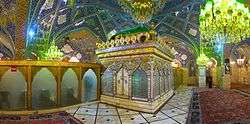Zarih


A Zarih (Template:Lang-urdu) is an ornate lattice structure, usually gilded, that encloses a grave in a mosque or Islamic Shrine .[1]
Zarihs are built from the finest materials and by some of the most skilled craftsmen; from calligraphers, metal workers, jewelers, carpenters, designers and even engineers. The composition of these craftsmen who are all masters in their fields form this delicate and sacred craft. Zarih's are often the size of a small room and built completely by hand in a process that often takes several years.
Not all Zarihs are of the same quality however, the most intricate Zarihs found, are often in the Shrines of Shia Imams and are seldomly built, these Zarihs take far longer to construct and use far more sophisticated materials and measures than simpler and smaller Zarihs.
A Zarih serves as a marker for the tombs of religious figures, and symbol of their sacred nature, and more importantly they are a manifestation of people’s love and devotion for these saintly figures. Zarihs are always funded by donations, people from all social classes donate what they can to fund these projects, it is considered a blessing to do so. The actual construction and installation of Zarihs is also done on a completely volunteer basis.
The walls of the Zarih are filled with verses of the Quran, names of Holy Figures and other exquisite artwork. [1] A zarih is often made as a waqf with its creators demanding no pay for their work. Notable ones are found in the Imam Husayn Shrine, the Al Abbas Mosque, the Sayyidah Ruqayya Mosque, the Imam Ali Mosque, and elsewhere.
References
- 1 2 "Archived copy". Archived from the original on December 7, 2014. Retrieved June 22, 2014.
.jpg)


